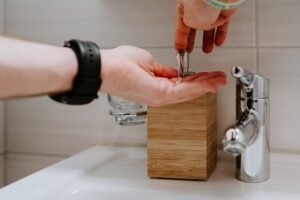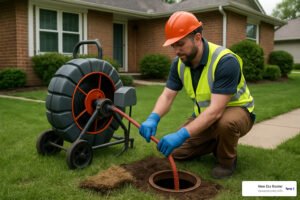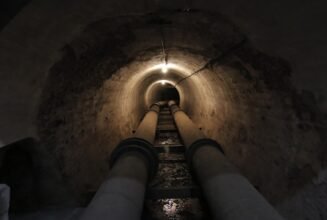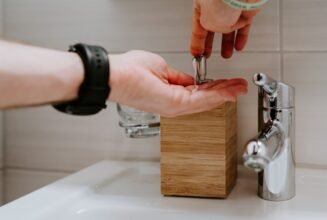Why Installing a Bathroom Faucet is a Smart DIY Project
Installing a bathroom faucet is one of the most rewarding DIY projects you can tackle in just 1-2 hours. Here’s what you need to know:
Quick Installation Overview:
- Turn off water at shutoff valves under sink
- Remove old faucet by disconnecting supply lines and mounting nuts
- Clean sink surface and prepare new faucet with gaskets
- Mount new faucet and tighten basin nuts evenly
- Connect supply lines with Teflon tape for leak prevention
- Test for leaks by running water for one minute
Most homeowners can complete this beginner-level project with basic tools like an adjustable wrench and basin wrench. The average cost for DIY installation runs just $20-50 (not including the faucet), compared to hiring a professional.
Why tackle this yourself? Upgrading to a WaterSense-labeled faucet can reduce water use by at least 20% compared to standard models. Plus, modern flexible braided supply lines make installation much easier than the rigid metal tubing used in older homes.

Installing a Bathroom Faucet: Prep, Tools, and Old-Fixture Removal

Installing a bathroom faucet becomes surprisingly manageable with proper preparation and the right tools. The secret isn’t being a plumbing expert – it’s taking your time and not skipping the prep work.
Essential Tools & Materials for Installing a Bathroom Faucet
You don’t need professional plumbing tools, but having the right basics makes all the difference. The adjustable wrench and basin wrench are essential – the adjustable wrench handles supply line connections, while the basin wrench reaches those awkward mounting nuts behind your sink.
You’ll also need channel-lock pliers for stubborn fittings, a screwdriver set, and a flashlight or headlamp for working in tight, dark spaces.
For materials, plumber’s tape (Teflon tape) creates leak-free threaded connections. You’ll need plumber’s putty or silicone caulk to seal the faucet base, and flexible braided supply lines which are much more forgiving than old rigid tubing.
Keep penetrating oil handy for corroded fittings, and don’t forget safety glasses. A quality adjustable wrench is worth the investment since cheap ones tend to slip and damage fittings.
Choosing the Right Faucet & Sink Compatibility
Nearly all bathroom sinks fall into three categories based on hole spacing.
Single-hole faucets are the simplest option with everything integrated into one piece. They offer a clean, modern look and the easiest installation.
Centerset faucets use three holes with exactly 4 inches between the outer holes. This is the most common residential setup, with separate hot and cold handles flanking the spout.
Widespread faucets also use three holes but with 8 inches between the outer holes. These require separate valves connected under the sink, making installation more complex but delivering a premium look.
Look for WaterSense-labeled faucets that meet EPA efficiency standards. These models typically use 1.2 gallons per minute compared to 2.2 gpm for standard faucets.
| Feature | Single-Handle | Widespread |
|---|---|---|
| Installation Complexity | Beginner | Intermediate |
| Typical Cost | $50-200 | $150-500+ |
| Water Control | One lever | Separate hot/cold |
| Style Options | Modern/Contemporary | Traditional/Luxury |
| Maintenance | Simple | More components |
Turning Off Water & Safely Removing the Old Faucet
Start by locating the under-sink valves – you should find two shutoff valves, with hot water typically on the left and cold on the right. Turn them clockwise to close. If the shutoff valves are seized, you’ll need to locate your main shutoff valve near your water meter.
Once the water is off, relieve pressure by turning on the old faucet and letting remaining water drain out.
Supply line disconnect comes next. Place your bucket under the connections and use your adjustable wrench to disconnect the supply lines from the shutoff valves.
The mounting nuts are your next challenge, and this is where that basin wrench becomes invaluable. These nuts are typically located behind the sink where regular wrenches can’t reach. If they’re corroded, spray them with penetrating oil and wait 10-15 minutes.
Disconnect the lift rod that connects to your drain stopper, then remove the old fixture and clean the sink surface thoroughly with rubbing alcohol.
Step-by-Step Guide to Installing a Bathroom Faucet & Leak-Free Finish

Installing a Bathroom Faucet: Mounting Hardware & Handles
Start by preparing your new faucet before installation. Apply plumber’s putty or silicone caulk around the base where the faucet will sit on your sink to create a watertight seal.
Position the faucet through the mounting holes. If using a deck plate to cover extra holes, get that in place first with its gasket. Check the distance from both sides of the faucet to the sink edges to ensure it’s centered.
Secure everything from underneath the sink. Slide the rubber gasket up the faucet shank, followed by the mounting nut. Hand-tighten the nut first to avoid cross-threading, then use your basin wrench for final tightening. If you have multiple mounting points, alternate between nuts, tightening each gradually.
Avoid over-tightening – snug is perfect. Over-tightening can crack porcelain sinks or damage gaskets.
Connecting Water Supply Lines & Drain Assembly
Start by wrapping threads on both the faucet shanks and shutoff valves with plumber’s tape. Wrap it clockwise – the same direction you’ll turn the nuts.
Connect the supply lines to your faucet first – it’s easier to work with the faucet end before crawling under the sink. Hand-tighten those nuts, then use your adjustable wrench to snug them up. Remember: hot water typically goes to the left, cold to the right.
Connect supply lines to the shutoff valves using the same hand-tighten-first approach.
For the drain assembly, apply silicone caulk to the underside of the drain flange, install it in the sink’s drain hole, then work from underneath to install the rubber gasket, friction ring, and locknut.
The pop-up assembly connects the ball rod through the drain body to the lift rod strap with a metal clip. Adjust the height so your stopper opens and closes properly.
For a comprehensive visual guide, this in-depth DIY tutorial walks through each step with helpful photos.
Final Leak Check, Common Mistakes, and Maintenance Tips
Turn those shutoff valves back on slowly – start with quarter-turns and listen for anything unusual. If everything sounds normal, open them fully.
Unscrew the aerator and let both hot and cold water run for a full minute. This flushes out any debris from the installation process.
Comprehensive leak check – inspect every connection: under-sink supply lines, the faucet base, all drain connections, and the pop-up assembly. Run water for several minutes and check periodically.
Common mistakes to avoid: Over-tightening connections is the biggest culprit for leaks. Forgetting to wrap threads with plumber’s tape, mixing up hot and cold, skipping the flush step, and not checking alignment.
For long-term performance, wipe down monthly to prevent mineral buildup. Check under-sink connections quarterly for moisture. Once a year, remove and clean the aerator – soak it in white vinegar to dissolve mineral deposits.
When to Call a Pro & Project Timing FAQs
Call a professional if shutoff valves are missing or don’t work, you have corroded or damaged supply pipes, or the installation requires rerouting plumbing behind walls.
Plan on 2-3 hours if this is your first installation. Experienced DIYers usually finish in 1-2 hours. Budget-wise, expect $20-50 in supplies for DIY installation, compared to $150-300 for professional installation.
Conclusion & 24/7 Help From New Era Rooter

Congratulations – you’ve just mastered installing a bathroom faucet like a professional! This project proves that with proper preparation, tools, and patience, you can tackle plumbing tasks that might have seemed impossible before.
Key takeaways: proper preparation prevents problems, take your time with each step, don’t over-tighten connections, and always test thoroughly before calling it done.
At New Era Rooter, we serve folks throughout Lake Elsinore, Temecula, San Diego, and surrounding areas with expert plumbing solutions. While we support DIY when it makes sense, we’re here when you need professional help.
Call us when you run into unexpected complications, your home has older plumbing that needs updating, you want professional installation peace of mind, or you need emergency plumbing service any time of day or night.
Our skilled professionals are available 24/7 for emergency service, and we deliver efficient, long-lasting results for both residential and commercial clients. Whether you’re dealing with a straightforward faucet installation or a complex plumbing emergency, we have the expertise to get it done right the first time.
For more information about our comprehensive plumbing services, check out More info about our plumbing services. From routine maintenance to emergency repairs, we’re your trusted partner for all things plumbing in Southern California.
Remember: a successful DIY project starts with knowing when to tackle it yourself and when to call the professionals. Either way, you now have the knowledge to make an informed decision about installing a bathroom faucet in your home.











